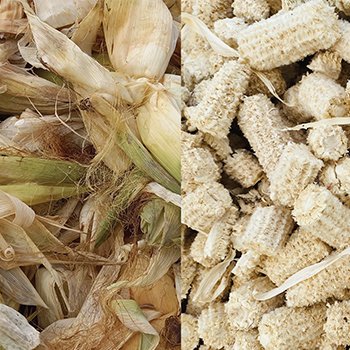นวัตกรรมบรรจุภัณฑ์: การใช้ประโยชน์เส้นใยและเซลลูโลสจากวัสดุเหลือทิ้งทางการเกษตร Packaging Innovation: Application of Fiber and Cellulose from Agricultural Wastes
3101 Views |

By: ผศ.ดร. สุฐพัศ คำไทย
Assist. Prof. Suthaphat Khamthai, Ph.D.
Department of Packaging Technology
Faculty of Agro-Industry
Lanna Rice Research Center
Chiang Mai University
suthaphat.k@cmu.ac.th
การใช้ประโยชน์จากวัสดุเหลือทิ้งทางการเกษตรเพื่อพัฒนาเป็นบรรจุภัณฑ์อาหารรักษ์โลก ดังนี้
1. กระบวนการผลิตคาร์บอกซีเมทิลเซลลูโลสและสีคาร์บอกซีเมทิลเซลลูโลสจากวัสดุเหลือทิ้งทางการเกษตร
การใช้ประโยชน์เซลลูโลสจากเศษเหลือทางการเกษตร เช่น ฟางข้าว เปลือกข้าวโพด ซังข้าวโพด ชานอ้อย กากกาแฟ แกนกัญชง มาผลิตเป็นอนุพันธ์เซลลูโลส ได้แก่ คาร์บอกซีเมทิลเซลลูโลส (carboxymethyl cellulose) ซึ่งมีการพัฒนากระบวนการผลิตสีคาร์บอกซีเมทิลเซลลูโลส (carboxymethyl cellulose dye; CMC dye) โดยใช้กระบวนการเอนแคปซูเลชัน (encapsulation) ให้มีสีสันสวยงาม ทนทานต่อความร้อน สามารถนำไปใช้เป็นสีผสมอาหาร สารก่อฟิล์ม รวมถึงใช้เป็นผงสีที่กักเก็บสารแอนโทไซยานิน (ภาพที่ 2) โดยงานวิจัยเรื่องนี้ได้รับสิทธิบัตรหมายเลข 95489 เรื่องกระบวนการผลิตคาร์บอกซีเมทิลเซลลูโลสจากเศษเหลือทิ้งทางการเกษตร
2. บรรจุภัณฑ์เยื่อกระดาษขึ้นรูปแบบแอคทีฟจากฟางข้าว (Active molded pulp packaging)
บรรจุภัณฑ์เยื่อกระดาษขึ้นรูปแบบแอคทีฟ เป็นการพัฒนาสมบัติพื้นฐานของบรรจุภัณฑ์กระดาษให้มีหลากหลายหน้าที่ ได้แก่ การดูดซับก๊าซเอธิลีน การยับยั้งเชื้อแอนแทรคโนส (Colletotrichum sp.) กันน้ำ กันน้ำมัน และย่อยสลายได้ 100% โดยนำเยื่อฟางข้าวและเยื่อชานอ้อยมาใช้เป็นวัตถุดิบหลักในการผลิตบรรจุภัณฑ์เยื่อกระดาษขึ้นรูปซึ่งเป็นภาชนะที่สัมผัสกับอาหารได้โดยตรง สะอาด ปลอดภัย และปราศจากโลหะหนัก (ภาพที่ 3) นอกจากนี้งานวิจัยยังได้พัฒนาต่อยอดขึ้นมาเป็นงานวิจัยบรรจุภัณฑ์เยื่อกระดาษขึ้นรูปจากฟางข้าว โดยได้เพิ่มฟังก์ชันพิเศษให้กับบรรจุภัณฑ์ ซึ่งอาศัยการขึ้นรูปบรรจุภัณฑ์รูปแบบใหม่ (ภาพที่ 4) ช่วยทำหน้าที่ในการชะลอการสุกของมะม่วง ลดการเกิดจุดดำ กันกระแทกระหว่างการขนส่ง อีกทั้งยังมีความสวยงาม และสามารถยืดอายุการเก็บรักษามะม่วงได้มากกว่า 3 สัปดาห์ (หรือมากกว่า 21 วัน) ณ อุณหภูมิการส่งออกของมะม่วง
3. ฟิล์มบริโภคได้จากพืช (Plant-based edible film)
เนื่องจากคาร์บอกซีเมทิลเซลลูโลส (carboxymethyl cellulose; CMC) ที่ผลิตจากวัสดุเหลือทิ้งทางการเกษตรจัดอยู่ในกลุ่มพอลิเมอร์ชีวภาพ (biopolymer) ซึ่งเป็นกลุ่มพอลิแซ็กคาไรด์ (polysaccharide based biopolymer) ที่มีสมบัติเป็นสารก่อฟิล์ม (film forming agent) สามารถผลิตเป็นฟิล์มชนิดใหม่ที่มีสมบัติทางกายภาพ สมบัติเชิงกล สมบัติการสกัดกั้นไอน้ำและน้ำมัน
Some examples of the application of agricultural wastes for sustainable food packaging are as follows:
1. Production of Carboxymethyl Cellulose Dye from Agricultural Wastes
Cellulose from agricultural wastes – rice straw, corn husk, corncob, bagasse, coffee ground, and hemp stalk – can be used to produce a new cellulose derivative called carboxymethyl cellulose. Moreover, one particular study has successfully developed carboxymethyl cellulose dye (CMC dye) via encapsulation technique. The resulting CMC dye yields beautiful color, features high heat resistance, and can be used in food products, either as film-forming agent or as an agent for anthocyanin encapsulation (Figure 2). This research has received a patent number of 95489, which covers the production process of agricultural waste-derived carboxymethyl cellulose.
2. Active Molded Pulp Packaging
Active molded pulp packaging is an enhancement of the fundamental properties of conventional paper packaging. This new type of packaging features diverse functional properties such as ethylene absorption, inhibition of anthracnose-inducing Collectotrichum sp., waterproofness, oil impermeability, and total biodegradability. Fibers from rice straw and bagasse are used as the main raw materials of active molded pulp packaging, which tends to have direct contact with food and must be clean, safe, and heavy metal-free (Figure 3). Branching out from this research, another study has discovered a way to create an active molded pulp packaging from rice straw, which boasts additional special functions based on a novel packaging molding technique (Figure 4). As a result, this new, aesthetically appealing packaging can be used with mangoes to delay maturation, reduce black spots, prevent shocks during transit, and prolong shelf life to more than 3 weeks (21 days) at export temperature.
3. Plant-based Edible Film
Since carboxymethyl cellulose (CMC) from agricultural wastes is a polysaccharide-based biopolymer, it can be used as film-forming agent to produce a film that has new physical, mechanical, water vapor barrier, and oil barrier properties.






